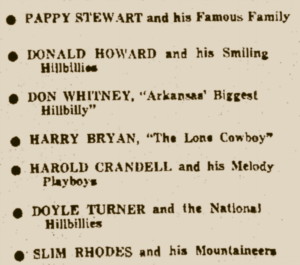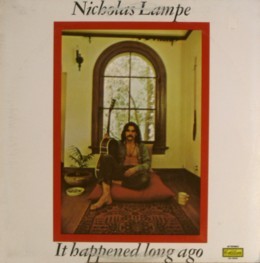Hal Saunders (1904-1991) was born James Hallett Saunders in Armidale NSW. He was a prolific songwriter who made a name for himself writing radio serials from the mid-1930s before going into the music business in the 50s and 60s. He was also a visual artist specialising in etching and printmaking.
On his retirement from Festival Records in 1965 (noted in Billboard and Cash Box), Saunders was referred to as a producer, composer, arranger and musical director. That is a good start, but it leaves out lyricist, adapter, jingle-writer, scriptwriter, A&R man, pianist and bandleader.
Michael Looper has tracked Saunders' job titles at Festival from 1954 to 1960: musical director, musical consultant in charge of local recording activities, recording supervisor and assistant A&R manager. He was a prominent office-holder and advocate in songwriters' associations including APRA in the late 40s-early 50s.
 |
| Women's Weekly 6 June 62 [source] |
In the first half of the 1960s he wrote and (mainly) co-wrote for the latest crop of young pop stars at Festival. Frequent among his collaborators were influential Festival A&R man Ken Taylor and the multi-talented Franz Conde, at this time time a musical director at Festival.
With Taylor, Saunders wrote or arranged for Vic Sabrino, Johnny Devlin and Ray Melton. With Conde, there were a lot of adaptations: traditional children's songs, a Christmas EP for Noeleen Batley, and an EP of traditional celebration songs for Col Joye.
As an adapter, Saunders also contributed to Jimmy Little's hit version of the old gospel song Royal Telephone (1963), and he wrote the English lyrics for Noeleen Batley's Little Treasure From Japan (1964) from the Japanese song Konnichiwa Akachan. April Byron, Judy Stone, Patty Markham, Noeleen Batley, and Lana Cantrell all recorded tracks with credits to Hal Saunders as writer, co-writer or adapter.
As a pianist in the 1930s he had led a swing quartet, Hal's Vagabonds, for at least one gig in Northern NSW, and his job descriptions at Festival included arranging and musical direction. Besides, his solo compositions confirm that he could write lyrics and compose music.
As for lyrics, when Peter Scriven produced Tintookies (1956), his well-known marionette musical for children, Saunders wrote the book and the lyrics.
For Nex'Town (1957), a musical devised and produced by Scriven, Saunders co-wrote the music and lyrics. His collaborator on Nex'Town, Iris Mason, later co-wrote the music for Saunders' own work for marionettes, Tales From Noonameena: an Operetta for Children (1973), staged at the opening of the Sydney Opera House.
Saunders' ability as a lyricist is unsurprising. He had started earning a living as a writer for Sydney radio during the 1930s when he wrote advertising copy and lyrics for jingles, but he went on to become one of the top radio playwrights in the country. |
| Nov 1935 [full story] |
He is often identified with his popular serial The Black Spider (1935), a mystery set in Sydney that was first aired on 2KY, later on 3XY and other stations. A novelisation was published by Magpie Books in 1945.
A Sydney newspaper story in November 1935 announces the final episode of The Black Spider, but plugs a forthcoming comedy by Saunders, Gambler's Luck, as well as his Sunday morning adventure serial Jack Strong's Gold Reef. A few weeks later 2KY was airing Saunders' true-crime-based serial Sydney's Crime Sheet (early 1936), apparently commissioned in response to a similar show on another station.
This activity signalled a boom time for Australian radio that would last into the 1950s, an era when Australian variety and drama dominated programming. As Will Newton puts it in an overview of the period, I have always thought that Australian radio drama came into its own thanks, largely, to Hal Saunders.
Away from the performing arts, the Australian Prints + Printmaking website has information about Hal Saunders, a print-seller, printer, printmaker, publisher, and writer, noted for his etchings.
A reader might not guess that this is Hal Saunders the A&R man or the writer of The Black Spider, but the connection is made clear in a February 1937 Wireless Weekly article. Saunders talks about a medical crisis that forced him to abandon an earlier career in the legal profession. After recovering, he studied Art, and in 1928 he "toured New Zealand on behalf of the Commonwealth Government with paintings and etchings by Australian artists".
At the time of the Wireless Weekly article, Saunders had just written Hotel Revue, a musical comedy for radio with music by pianist Cliff Arnold.
Saunders says he "brought along half a dozen melodies" to the first meeting with Arnold but confessed his "knowledge of music was non est". Perhaps this meant that he lacked knowledge of musical technicalities, or perhaps he was being modest, or just building a narrative. Whatever the explanation, by December of 1937 he knew enough to handle the piano in Hal's Vagabonds, and by 1954 he was a musical director at Festival Records.
_____________________________
1. It is hard to verify the reporter's figure of about 1,000 songs in 15 years, but a song every 5½ days or so seems doable. Besides, Saunders' voluminous output as a radio playwright shows that he had the drive and ability to work quickly and prolifically.
Sources
• Many newspaper and magazine articles at Trove.com.au, Newspapers.com and NewspaperArchives.com, so allow for reporters' errors and recycling of promotional material. See links in the text and email me for more.
• Discographic data at 45cat.com, 45worlds.com and Discogs.com.
• Nancy Bridges, Wonderful Wireless (1983) pp 48-50
• Will Newton. "Wonderful World of Wireless: Golden Years of Radio", Sutherland Shire Historical Society Inc Quarterly Bulletin, February 1993
_____________________________
The Black Spider premières, October 1935 [source]
To-night at 6.45. the first episode in “The Black Spider,” a 2KY mystery thriller, will be presented. Written by Hal Saunders, 2KY Playwright, “The Black Spider,” is a gripping story of crime and murder set in and around Sydney. The ingenuity of "The Black Spider" and his gang tests to the utmost the skill of Inspector McMillan and his colleague. Martin Purlow, the famous detective. Besides the intense and exciting action which permeates the whole of this story, the author has introduced a generous splash of mystery, which makes it safe to assume that right until the final episode the true identity of "The Black Spider" cannot even be suspected. In the presentation of this original all-Australian serial. 2KY is definitely making radio history, for this is the first occasion on which a serial of this type has been featured by any Australian broadcasting station. Included in the cast are: Dan Weldon, George Jennings, Harry McDonald, and Sylvia Post Mason.
 |
| February 1936: Sydney's Crime Sheet [source] |
 |
| September 1940: The Secret of Smokyville [source] |


















